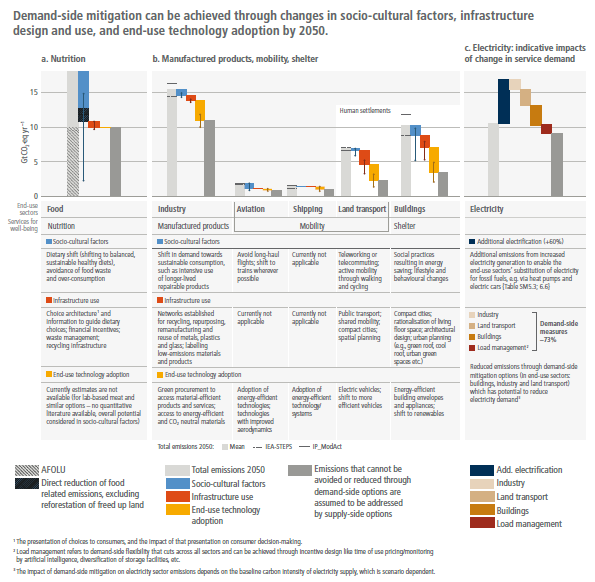Figure TS.21
Figure caption
Figure TS.21 | Demand-side mitigation can be achieved through changes in socio-cultural factors, infrastructure design and use, and technology adoption. Mitigation response options related to demand for services have been categorised into three domains: ‘socio-cultural factors’, related to social norms, culture, and individual choices and behaviour; ‘infrastructure use’, related to the provision and use of supporting infrastructure that enables individual choices and behaviour; and ‘technology adoption’, which refers to the uptake of technologies by end users. Potentials in 2050 are estimated using the International Energy Agency’s 2020 World Energy Outlook STEPS (Stated Policy Scenarios) as a baseline. This scenario is based on a sector-by-sector assessment of specific policies in place, as well as those that have been announced by countries by mid-2020. This scenario was selected due to the detailed representation of options across sectors and sub-sectors. The heights of the coloured columns represent the potentials on which there is a high level of agreement in the literature, based on a range of case studies. The range shown by the dots connected by dotted lines represents the highest and lowest potentials reported in the literature which have low to medium levels of agreement. The demand-side potential of socio-cultural factors in the food system has two parts. The economic potential of direct emissions (mostly non-CO2) demand reduction through socio-cultural factors alone is 1.9 GtCO2-eq without considering land-use change by diversion of agricultural land from food production to carbon sequestration. If further changes in land use enabled by this change in demand are considered, the indicative potential could reach 7 GtCO2-eq. The electricity panel presents separately the mitigation potential from changes in electricity demand and changes associated with enhanced electrification in end-use sectors. Electrification increases electricity demand, while it is avoided though demand-side mitigation strategies. Load management refers to demand-side flexibility that can be achieved through incentive design such as time-of-use pricing/monitoring by artificial intelligence, diversification of storage facilities, and so on. NZE (IEA Net-Zero Emissions by 2050 scenario) is used to compute the impact of end-use sector electrification, while the impact of demand-side response options is based on bottom-up assessments. Dark grey columns show the emissions that cannot be avoided through demand-side mitigation options. The table indicates which demand-side mitigation options are included. Options are categorised according to: socio-cultural factors, infrastructure use, and technology adoption. Figure SPM.7 covers potential of demand-side options for the year 2050. Figure SPM.8 covers both supply- and demand-side options and their potentials for the year 2030. {5.3, Figure 5.7, 5.SM.II}
